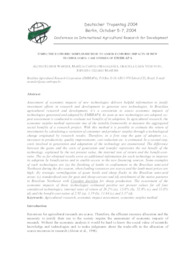Using the economic surplus method to assess economic impacts of new technologies: case studies of Embrapa.
Using the economic surplus method to assess economic impacts of new technologies: case studies of Embrapa.
Autoria: WANDER, A. E.; MAGALHÃES, M. C.; VEDOVOTO, G. L.; MARTINS, E. C.
Resumo: Abstract - Assessment of economic impacts of new technologies delivers helpful information to justify investment efforts in research and development to generate new technologies. In Brazilian agricultural research and development, it?s a convention to assess economic impacts of technologies generated and adapted by EMBRAPA. As soon as new technologies are adopted, expost assessment is conducted to evaluate net benefits of its adoption. In agricultural research, the economic surplus method represents one of the suitable frameworks to measure the aggregated social benefits of a research project. With this method it is possible to estimate the return of investments by calculating a variation of consumer and producer surplus through a technological change originated by research results. Therefore, in a first step the gain of adoption i.e., increases in productivity, quality improvements, cost reduction etc. is estimated. In a second step, costs involved in generation and adaptation of the technology are enumerated. The difference between the gains and the costs of generation and transfer represents the net benefit of the technology, explained by the net present value, the internal rate of return and the benefit-costratio. The so far obtained results serve as additional information for each technology to improve its adoption by beneficiaries and to enable access to the new financing sources. Some examples of such technologies are (a) the finishing of lambs in confinement in the Brazilian semi-arid Northeast during the dry season, when feeding resources are scarce and the lamb meat prices are high; (b) strategic vermifugation of goats herds and sheep flocks in the Brazilian semi-arid areas; (c) standardized cuts for goat and sheep carcass and (d) enrichment of the native pastures in Brazilian Northeast with Cynodon dactylon for sheep production. The assessment of the economic impacts of these technologies estimated positive net present values for all four considered technologies, internal rates of return of 26.2% (a), 13.8% (b), 52.8% (c) and 31.0% (d) and the benefit-cost-ratios of 2.92 (a), 1.19 (b), 11.64 (c) and 3.37 (d).
Ano de publicação: 2004
Tipo de publicação: Artigo em anais e proceedings
Unidade: Embrapa Caprinos e Ovinos
Observações
1 - Por padrão são exibidas publicações dos últimos 20 anos. Para encontrar publicações mais antigas, configure o filtro ano de publicação, colocando o ano a partir do qual você deseja encontrar publicações. O filtro está na coluna da esquerda na busca acima.
2 - Para ler algumas publicações da Embrapa (apenas as que estão em formato ePub), é necessário ter, no celular ou computador, um desses softwares gratuitos. Sistemas Android: Google Play Livros; IOS: iBooks; Windows e Linux: software Calibre.
Acesse outras publicações
Acesse a Base de Dados da Pesquisa Agropecuária (BDPA) para consultar o acervo completo das bibliotecas da Embrapa.

